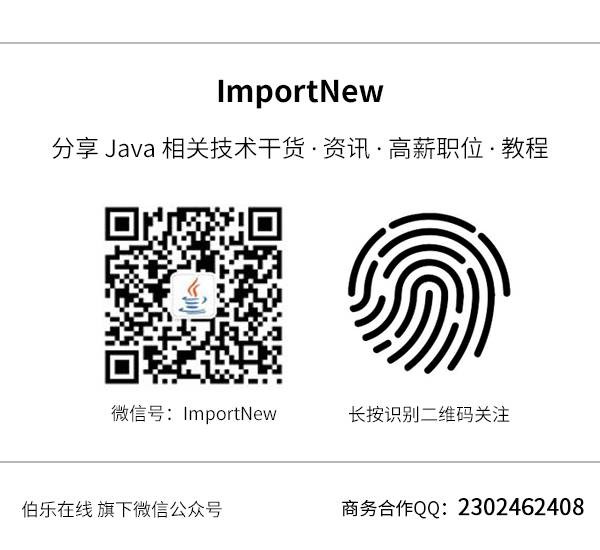(點選上方公眾號,可快速關註)
來源:hengyunabc ,
blog.csdn.net/hengyunabc/article/details/75453307
Spring裡的佔位符
spring裡的佔位符通常表現的形式是:
或者
@Configuration
@ImportResource(“classpath:/com/acme/properties-config.xml”)
public class AppConfig {
@Value(“${jdbc.url}”)
private String url;
}
Spring應用在有時會出現佔位符配置沒有註入,原因可能是多樣的。
本文介紹兩種比較複雜的情況。
佔位符是在Spring生命週期的什麼時候處理的
Spirng在生命週期裡關於Bean的處理大概可以分為下麵幾步:
-
載入Bean定義(從xml或者從@Import等)
-
處理BeanFactoryPostProcessor
-
實體化Bean
-
處理Bean的property註入
-
處理BeanPostProcessor
當然這隻是比較理想的狀態,實際上因為Spring Context在構造時,也需要建立很多內部的Bean,應用在介面實現裡也會做自己的各種邏輯,整個流程會非常複雜。
那麼佔位符(${}運算式)是在什麼時候被處理的?
-
實際上是在org.springframework.context.support.PropertySourcesPlaceholderConfigurer裡處理的,它會訪問了每一個bean的BeanDefinition,然後做佔位符的處理
-
PropertySourcesPlaceholderConfigurer實現了BeanFactoryPostProcessor介面
-
PropertySourcesPlaceholderConfigurer的 order是Ordered.LOWEST_PRECEDENCE,也就是最低優先順序的
結合上面的Spring的生命週期,如果Bean的建立和使用在PropertySourcesPlaceholderConfigurer之前,那麼就有可能出現佔位符沒有被處理的情況。
例子1:Mybatis 的 MapperScannerConfigurer引起的佔位符沒有處理
例子程式碼:mybatis-demo.zip
https://github.com/hengyunabc/hengyunabc.github.io/files/1158339/mybatis-demo.zip
首先應用自己在程式碼裡建立了一個DataSource,其中${db.user}是希望從application.properties裡註入的。程式碼在執行時會打印出user的實際值。
@Configuration
public class MyDataSourceConfig {
@Bean(name = “dataSource1”)
public DataSource dataSource1(@Value(“${db.user}”) String user) {
System.err.println(“user: ” + user);
JdbcDataSource ds = new JdbcDataSource();
ds.setURL(“jdbc:h2:˜/test”);
ds.setUser(user);
return ds;
}
}
然後應用用程式碼的方式來初始化mybatis相關的配置,依賴上面建立的DataSource物件
@Configuration
public class MybatisConfig1 {
@Bean(name = “sqlSessionFactory1”)
public SqlSessionFactory sqlSessionFactory1(DataSource dataSource1) throws Exception {
SqlSessionFactoryBean sqlSessionFactoryBean = new SqlSessionFactoryBean();
org.apache.ibatis.session.Configuration ibatisConfiguration = new org.apache.ibatis.session.Configuration();
sqlSessionFactoryBean.setConfiguration(ibatisConfiguration);
sqlSessionFactoryBean.setDataSource(dataSource1);
sqlSessionFactoryBean.setTypeAliasesPackage(“sample.mybatis.domain”);
return sqlSessionFactoryBean.getObject();
}
@Bean
MapperScannerConfigurer mapperScannerConfigurer(SqlSessionFactory sqlSessionFactory1) {
MapperScannerConfigurer mapperScannerConfigurer = new MapperScannerConfigurer();
mapperScannerConfigurer.setSqlSessionFactoryBeanName(“sqlSessionFactory1”);
mapperScannerConfigurer.setBasePackage(“sample.mybatis.mapper”);
return mapperScannerConfigurer;
}
}
當程式碼執行時,輸出結果是:
user: ${db.user}
為什麼會user這個變數沒有被註入?
分析下Bean定義,可以發現MapperScannerConfigurer它實現了BeanDefinitionRegistryPostProcessor。這個介面在是Spring掃描Bean定義時會回呼的,遠早於BeanFactoryPostProcessor。
所以原因是:
-
MapperScannerConfigurer它實現了BeanDefinitionRegistryPostProcessor,所以它會Spring的早期會被建立
-
從bean的依賴關係來看,mapperScannerConfigurer依賴了sqlSessionFactory1,sqlSessionFactory1依賴了dataSource1
-
MyDataSourceConfig裡的dataSource1被提前初始化,沒有經過PropertySourcesPlaceholderConfigurer的處理,所以@Value(“${db.user}”) String user 裡的佔位符沒有被處理
要解決這個問題,可以在程式碼裡,顯式來處理佔位符:
environment.resolvePlaceholders(“${db.user}”)
例子2:Spring boot自身實現問題,導致Bean被提前初始化
例子程式碼:demo.zip
https://github.com/spring-projects/spring-boot/files/773587/demo.zip
Spring Boot裡提供了@ConditionalOnBean,這個方便使用者在不同條件下來建立bean。裡面提供了判斷是否存在bean上有某個註解的功能。
@Target({ ElementType.TYPE, ElementType.METHOD })
@Retention(RetentionPolicy.RUNTIME)
@Documented
@Conditional(OnBeanCondition.class)
public @interface ConditionalOnBean {
/**
* The annotation type decorating a bean that should be checked. The condition matches
* when any of the annotations specified is defined on a bean in the
* {@link ApplicationContext}.
* @return the class-level annotation types to check
*/
Class extends Annotation>[] annotation() default {};
比如使用者自己定義了一個Annotation:
@Target({ ElementType.TYPE })
@Retention(RetentionPolicy.RUNTIME)
public @interface MyAnnotation {
}
然後用下麵的寫法來建立abc這個bean,意思是當使用者顯式使用了@MyAnnotation(比如放在main class上),才會建立這個bean。
@Configuration
public class MyAutoConfiguration {
@Bean
// if comment this line, it will be fine.
@ConditionalOnBean(annotation = { MyAnnotation.class })
public String abc() {
return “abc”;
}
}
這個功能很好,但是在spring boot 1.4.5 版本之前都有問題,會導致FactoryBean提前初始化。
在例子裡,透過xml建立了javaVersion這個bean,想獲取到java的版本號。這裡使用的是spring提供的一個呼叫static函式建立bean的技巧。
我們在程式碼裡獲取到這個javaVersion,然後打印出來:
@SpringBootApplication
@ImportResource(“classpath:/demo.xml”)
public class DemoApplication {
public static void main(String[] args) {
ConfigurableApplicationContext context = SpringApplication.run(DemoApplication.class, args);
System.err.println(context.getBean(“javaVersion”));
}
}
在實際執行時,發現javaVersion的值是null。
這個其實是spring boot的鍋,要搞清楚這個問題,先要看@ConditionalOnBean的實現。
-
@ConditionalOnBean實際上是在ConfigurationClassPostProcessor裡被處理的,它實現了BeanDefinitionRegistryPostProcessor
-
BeanDefinitionRegistryPostProcessor是在spring早期被處理的
-
@ConditionalOnBean的具體處理程式碼在org.springframework.boot.autoconfigure.condition.OnBeanCondition裡
-
OnBeanCondition在獲取bean的Annotation時,呼叫了beanFactory.getBeanNamesForAnnotation
private String[] getBeanNamesForAnnotation(
ConfigurableListableBeanFactory beanFactory, String type,
ClassLoader classLoader, boolean considerHierarchy) throws LinkageError {
String[] result = NO_BEANS;
try {
@SuppressWarnings(“unchecked”)
Class extends Annotation> typeClass = (Class extends Annotation>) ClassUtils
.forName(type, classLoader);
result = beanFactory.getBeanNamesForAnnotation(typeClass);
-
beanFactory.getBeanNamesForAnnotation 會導致FactoryBean提前初始化,創建出javaVersion裡,傳入的${java.version.key}沒有被處理,值為null。
-
spring boot 1.4.5 修複了這個問題:https://github.com/spring-projects/spring-boot/issues/8269
實現spring boot starter要註意不能導致bean提前初始化
使用者在實現spring boot starter時,通常會實現Spring的一些介面,比如BeanFactoryPostProcessor介面,在處理時,要註意不能呼叫類似beanFactory.getBeansOfType,beanFactory.getBeanNamesForAnnotation 這些函式,因為會導致一些bean提前初始化。
而上面有提到PropertySourcesPlaceholderConfigurer的order是最低優先順序的,所以使用者自己實現的BeanFactoryPostProcessor介面在被回呼時很有可能佔位符還沒有被處理。
對於使用者自己定義的@ConfigurationProperties物件的註入,可以用類似下麵的程式碼:
@ConfigurationProperties(prefix = “spring.my”)
public class MyProperties {
String key;
}
public static MyProperties buildMyProperties(ConfigurableEnvironment environment) {
MyProperties myProperties = new MyProperties();
if (environment != null) {
MutablePropertySources propertySources = environment.getPropertySources();
new RelaxedDataBinder(myProperties, “spring.my”).bind(new PropertySourcesPropertyValues(propertySources));
}
return myProperties;
}
總結
-
佔位符(${}運算式)是在PropertySourcesPlaceholderConfigurer裡處理的,也就是BeanFactoryPostProcessor介面
-
spring的生命週期是比較複雜的事情,在實現了一些早期的介面時要小心,不能導致spring bean提前初始化
-
在早期的介面實現裡,如果想要處理佔位符,可以利用spring自身的api,比如 environment.resolvePlaceholders(“${db.user}”)
看完本文有收穫?請轉發分享給更多人
關註「ImportNew」,看技術乾貨

 知識星球
知識星球